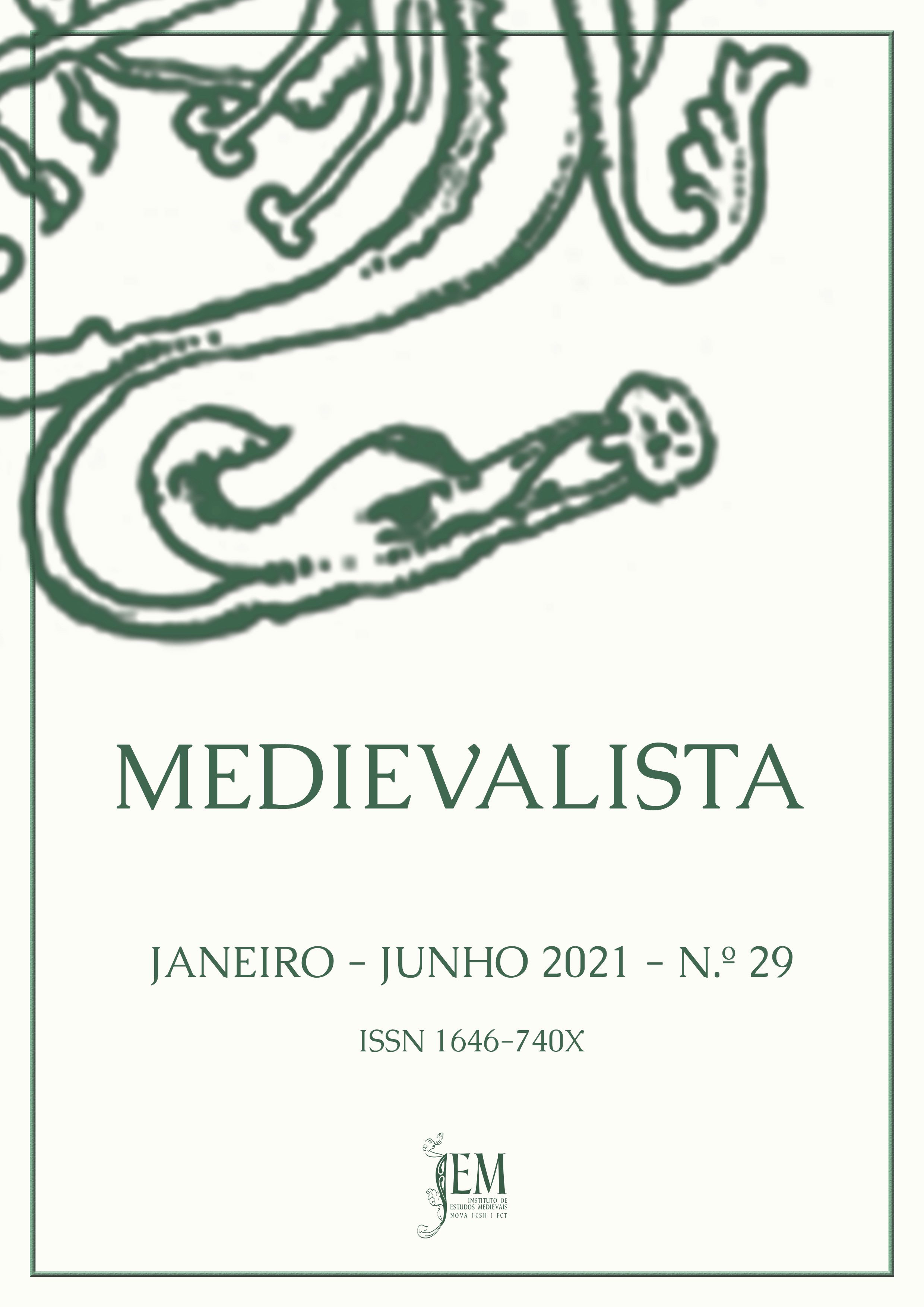Evidências de Patrocínio em Bestiários Medievais
DOI:
https://doi.org/10.4000/medievalista.3877Palavras-chave:
Patronagem, Bestiário de Aberdeen, Ashmole Ms. 1511Resumo
O presente artigo faz parte de uma pesquisa de mestrado em andamento na Universidade de Brasília (UnB), e propõe-se a indicar evidências visuais de patrocínio em dois bestiários medievais ingleses da segunda família, Bodley Ashmole Ms. 1511 e Aberdeen Bestiary Ms. 24. A proposta de patrocínio se apoia na teoria de que ambos são bestiários de luxo e de que possivelmente foram feitos por ao menos um iluminador em comum, e são resultado da cópia de um manuscrito base desconhecido. Procura-se afirmar esta teoria a partir de uma análise material e imagética dos manuscritos, onde dá-se foco na iluminura do pássaro Pica, chamado em português de Pêga. Tendo como base as teorias da relação entre texto-imagem e hierarquia de imagens, abordadas por diversos autores, o estudo feito aqui traça um paralelo comparativo entre os dois bestiários supracitados com outros seis manuscritos e identifica que há uma diferença além da estilística nas iluminuras. Considera-se que esta discrepância imagética pode estar relacionada ao patrocínio dos manuscritos, ou do manuscrito cujo modelo os serviu como base, nos fornecendo assim um olhar diferente e aprofundado sobre a produção de manuscritos de luxo e bestiários de luxo, e sua relação com a sociedade, como o consumo literário.
Referências bibliográficas
Fontes Manuscritas
Aberdeen, Aberdeen University Library, Ms. 24. Disponível em http://www.abdn.ac.uk/bestiary/.
Canterbury, Canterbury Cathedral Library, Ms. Lit. D 10. Disponível em: https://ims.canterbury-cathedral.org/advsearch.tlx?advsearchid=1537809368>.
Copenhague, Kongelige Bibliotek, Ms. Gl, kgl, S. 1633 4º. Disponível em http://www.kb.dk/permalink/2006/manus/221/eng/50+recto/?var=.
Los Angeles, Getty Museum, Northumberland Bestiary Ms. 100. Disponível em http://www.getty.edu/art/collection/objects/240115/unknown-maker-northumberland-bestiary-english-about-1250-1260/?dz=0.5000,0.5000,0.67.
Nova Iorque, Morgan Library Ms. 81. Disponível em http://ica.themorgan.org/manuscript/thumbs/77019.
Oxford, Bodleian Library, Ms. Ashmole 1511. Disponível em https://digital.bodleian.ox.ac.uk/inquire/p/fb43631c-1f61-4865-806c-9fe59b5753ff.
Paris, BnF, Ms. lat. 6838b. Disponível em http://mandragore.bnf.fr/ark:/12148/cgfbt65935s.
Paris, BnF, Ms. lat. 3630. Disponível em https://gallica.bnf.fr/ark:/12148/btv1b100329427/f90.image.r=3630%20bestiaire.
Estudos
BAXTER, Ron – Bestiaries and Their Users in the Middle Ages. Phoenix Mill: Sutton, 1998.
BAXTER, Ronald – “A baronial bestiary: heraldic evidence for the patronage of MS. Bodley 764”. Journal of the Warburg and Courtauld Institutes 50 (1987), pp. 196-200.
BENTON, Janetta Rebold – Materials, Methods, and Masterpieces of Medieval Art. Santa Barbara: ABC-CLIO, 2009.
CLARK, Willene B. – A Medieval Book of Beasts: The Second-Family Bestiary: Commentary, Art, Text and Translation. Woodbridge: Boydell Press, 2006.
CLARKE, Mark – “Anglo-Saxon manuscript pigments”. Studies in Conservation 49/4 (2004), pp. 231-244.
COWELL, Andrew – The Medieval Warrior Aristocracy: Gifts, Violence, Performance, and the Sacred. New York: Boydell & Brewer, 2007.
DAVIS, Henry William Carless; JOHNSON, Charles – Regesta regum anglo-normannorum, 1066-1154. Oxford: Clarendon Press, 1913.
DAVY, Marie-Madalene – Initiation à la Symbolique Romane. Paris: Flammarion, 1977.
DUBY, Georges – The early growth of the European economy: Warriors and peasants from the seventh to the twelfth century. New York: Cornell University Press, 1978.
DUBY, Georges – História Artística da Europa: A Idade Média, São Paulo: Editora Paz e Terra, 1997.
FOUILLOY, Hugh of; CLARK, Willene B. – The medieval book of birds: Hugh of Fouilloy’s Aviarium. Edition, translation and commentary by Willene B. Clark. Binghamton (N.Y.): Medieval and Renaissance texts and studies, 1992.
GÁL, Erika – «“Fine Feathers Make Fine Birds”: The Exploitation Of Wild Birds In Medieval Hungary». ANTÆUS 33 (2015), pp. 345-369, 2015.
GEDDES, Jane – “Observations on the Aberdeen Bestiary”. Reinardus. Yearbook of the International Reynard Society 11 (1998), pp. 67-84.
JAMES, Montague R. – The Bestiary. Oxford: Roxburghe Club, 1928.
JESSOP, Oliver – “A new artefact typology for the study of medieval arrowheads”. Medieval Archaeology 40/1 (1996), pp. 192-205.
JOHNS, Susan M. – Noblewomen, aristocracy and power in the twelfth-century Anglo-Norman realm. Manchester; New York: Manchester University Press, 2003.
KAY, Sarah – «'The English bestiary', the continental' Physiologus', and the intersections between them». Medium Aevum 85/1 (2016), pp. 118-142.
KUMLER, Aden – “The Patron-Function”. in HOURIHANE, Colum (ed.) – Patronage: Power and Agency in Medieval Art. University Park: Penn State University Press, 2013, pp. 297-319.
MCCULLOCH, Florence – Mediaeval Latin and French Bestiaries. Chapel Hill: University of North Carolina Press, 1962.
MCGRADY, Deborah – The Writer’s Gift or the Patron’s Pleasure? The Literary Economy in Late Medieval France. Buffalo: University of Toronto Press, 2019.
MERMIER, Guy R. – “The Phoenix: Its Nature and Its Place in the Tradition of the Physiologus”. in CLARK, Willene B.; McMUNN, Meradith T. (eds.) – Beasts and Birds of the Middle Ages: The Bestiary and Its Legacy. Philadelphia: University of Pennsylvania Press, 1989, pp. 69-85.
MURATOVA, Xenia – “Workshop Methods in English Late Twelfth-Century Illumination and the Production of Luxury Bestiaries”. in CLARK, Willene B.; McMUNN, Meradith T. (eds.) – Beasts and Birds of the Middle Ages: The Bestiary and Its Legacy. Philadelphia: University of Pennsylvania Press, 1989, pp. 53-68.
PASTOUREAU, Michel – Bestiaires du Moyen Âge. Paris: Seuil, 2011.
SCHMITT, Jean-Claude – O Corpo das Imagens: Ensaio Sobre a Cultura Visual na Idade Média. Bauru: EDUSC, 2007.
SERJEANTSON, Dale – “A dainty dish: consumption of small birds in Late Medieval England”. in BUITENHUIS, H. and PRUMMEL, W. (eds.) – Animals and Man in the Past. Essays in Honour of Dr. A.T. Clason, Emeritus Professor of Archaeozoology Rijksuniversiteit Groningen, the Netherlands. (ARC-Publicaties: Archaeological Research and Consultancy Publication, 41) Groningen, Holland: ARC-Publicaties, 2001, pp. 263-274.
STACYE, J. – “Priory and Parish Church of Worksop or Radford, Nottinghamshire”. Journal of the British Archaeological Association: First Series 30/2 (1874), pp. 156-170.
SWAINSON, Charles – Provincial Names and Folk Lore of British birds. Londres: English Dialect Society, Trübner and Co., 1885.
TEODORESCU, Bianca M.; CALIN, Răzvan-Alexandru; BUSU, Oprea-Valentin. – “Communication Gift Code”. New Approaches in Social and Humanistic Sciences 1/1(2016), pp. 503-506.
THOMAS, Hugh M. – The Secular Clergy in England, 1066-1216. Oxford: Oxford University Press, 2014.
VEGVAR, Carol Neuman de – “Birds of a Feather: Magpies in the Bayeux Tapestry?”. in FREDERICK, Jill; HYER, Maren Clegg (eds.) – Textiles, Text, Intertext: Essays in Honour of Gale R. Suffolk: Owen-Crocker. Boydell and Brewer, 2016, pp. 85-102.




















